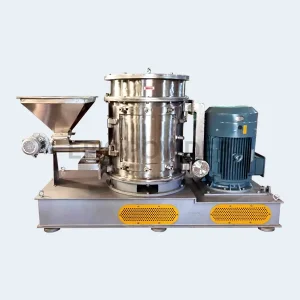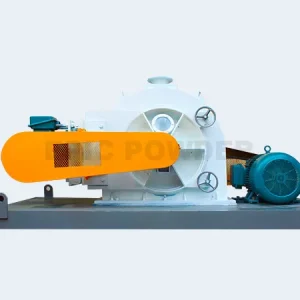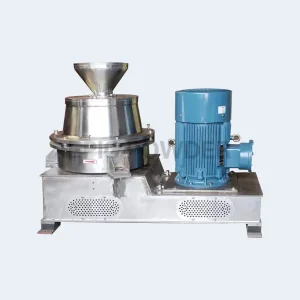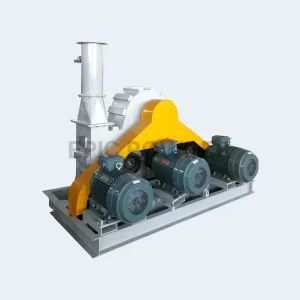Calcium carbonate is a water-loving inorganic compound. It has many hydroxyl structures on its surface. It has little affinity for organic polymers. It forms aggregates easily but disperses unevenly within them. This creates defects at the interfaces between composite materials. Direct application has poor results. These flaws become more obvious as the filling amount increases. Excessive filling may even make the product unusable. To enhance the reinforcing effect of calcium carbonate, we need to modify the powder. We also need to improve its dispersion in composites. This will improve the physical properties of calcium carbonate-filled composites. We should use different methods to broaden the material’s uses. This will make it a functional, reinforcing, and filling material.
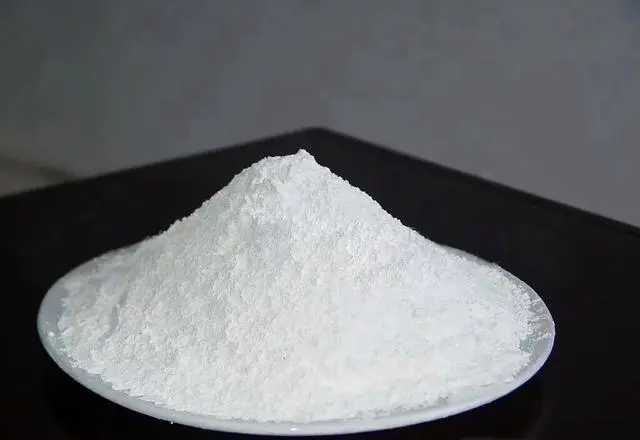
There are two main ways to modify calcium carbonate. One is to change the particle size. This makes the particles either fine or ultra-fine. It improves their dispersibility in resin. This change makes plastics, rubber, and other products stronger. It does so by letting particles reinforce them. The particles are tiny and have a large specific surface area.
The other way is to improve the surface of the powder. This changes it from being hydrophilic to lipophilic. This increases the powder’s compatibility with organic resins. This also improves the processing and physical and mechanical properties of the product.
This method mainly uses surface modifiers to activate the surface of calcium carbonate. The following introduces several main surface modifiers for calcium carbonate.
Inorganic modifier
Inorganic electrolyte dispersants stick to the surface of nano calcium carbonate. They can do two things. First, they create strong electrostatic repulsion by boosting the surface potential. Second, they induce a strong spatial repulsion effect.
At the same time, it can also make the surface of nano calcium carbonate more wettable to water. This prevents it from clumping in water.
Inorganic substances are commonly used. They mainly include condensed phosphoric acid, aluminate, and inorganic salts. They also have acid, alkali, alum, and inorganic ions. Nano calcium carbonate has poor acid resistance. This limits its scope of use. Phosphoric acid can modify its surface. This forms a complete and dense coating. The coating uses the hydrophobic effect. It also uses a steric hindrance to keep it from touching the inner hydrogen ions. This can improve the dispersal and activation of calcium carbonate. This will also improve its acid resistance and widen its applications.
The product’s pH is from 5.0 to 8.0. This is down 1.0~5.0 from before treatment. The product is hard to dissolve in weak acids like acetic acid. It has good acid resistance. This product can be used in industries. These include plastics, rubber, coatings, papermaking, food, and toothpaste.
Fatty acids and their salts modifiers
Fatty acid or stearate modifiers are traditional calcium carbonate fillers modifiers. They are inexpensive and have good modification effects on calcium carbonate fillers. This modifier type is mainly aliphatic, aromatic, or aralkyl. It contains hydroxyl, amino, or thiol groups. One end of this fatty acid molecule is a long-chain alkyl group. It is good at combining with polymers. The other end of RCOO can bond with calcium ions on the surface of calcium carbonate. This bond forms an active coating layer. It prevents calcium carbonate particles from clumping. The commonly used fatty acids are stearic acid and its salts. In addition, lignin, resin acid, and its salts can also be used to surface treat calcium carbonate.
Jea et al. I studied the effect of stearic acid-modified calcium carbonate on the flow of polypropylene. The results showed that it greatly improved the strength and toughness of polypropylene.
Phosphate modifiers
Phosphate ester mainly changes calcium carbonate powder. It does this by reacting Ca2+ with the powder’s surface with form an ester. This forms a calcium phosphate salt on the powder’s surface. This changes the powder’s properties. Phosphate ester compounds can modify calcium carbonate powder. This can greatly improve the processability and strength of composites. It also improves acid resistance and fire safety.
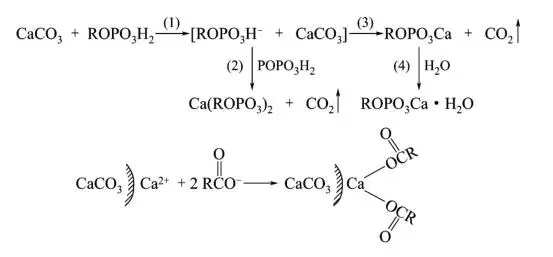
Yan et al. studied the microstructure and physical properties of PVC/new phosphate-modified nano-calcium carbonate composites. The results showed the modified nano-calcium carbonate toughened PVC composites a lot. It improved their physical properties.
Coupling agent modifier
The coupling agent is a substance with an amphiphilic structure. One part of the molecule has hydrophilic polar groups. They can react with functional groups on the powder’s surface. This forms strong chemical bonds. The other part has non-polar hydrophobic groups. They can react or tangle with organic polymers. This action firmly combines the calcium carbonate powder and the polymer matrix. These are two materials with very different properties. They combine them through the interface layer.
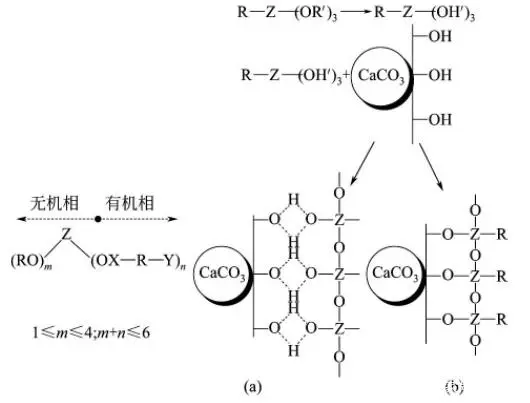
However, this method has three problems. First, the price of coupling agents is high. Second, different ones are selective for different polymers. Also, when used in some polymers, they can discolor. They are also prone to breaking down during storage or mixing.
Dozens of agents are used to treat calcium carbonate surfaces. They are used both at home and abroad. Commonly used coupling agents include silane, titanate, and aluminate. There are also composite coupling agents, etc.
Introduction of 4 coupling agents for modified calcium carbonate
A silane coupling agent
Silane coupling agent was developed early and is the most widely used type of coupling agent. For most silane coupling agents, there are too few hydroxyl groups. So, it is hard or even impossible to react with heavy calcium carbonate. The resin and silane coupling agent modify only when they have similar groups. He Yi et al. They chose the silane coupling agent KH560. They used it to modify the surface of heavy calcium carbonate. They put the modified heavy calcium carbonate into epoxy resin. This improved the thermal stability, compatibility, and corrosion resistance of the epoxy coating.
Titanate coupling agent
The Titanate Coupling Agent is a product. Kenrich Petrochemical Company in the United States developed it. They were made in the late 1970s. Titanate Coupling Agents are divided into types based on Molecular Structure. There are four types: monoalkoxy, monoalkoxy pyrophosphate, coordination, and chelate. Among them, monoalkoxy type is good for dry filler systems. These systems don’t contain free water. They have only chemically bonded or physically bonded water. The other three types of titanate coupling agents have no water content requirements.
Titanate Coupling Agents Affect Heavy Calcium Carbonate. The rubber industry uses it to cut the amount of rubber and antioxidants. It also improves product wear resistance and anti-aging performance. The coupling agent is added to the heavy calcium carbonate in the coating. It improves the dispersibility, fluidity, thermal stability, and mechanical properties. It is used in papermaking to enhance paper strength and printing. Although it is effective, it has many drawbacks. It oxidizes and discolors easily. It decomposes at low temperatures. Its organic end is prone to breakdown or hydrolysis. It is harmful to people and the environment. These flaws greatly limit its use.
Aluminate coupling agent
The Fujian Normal University created an aluminate coupling agent. It can improve a product’s strength and efficiency. It works like a titanate coupling agent. The aluminate coupling agent has advantages over the titanate coupling agent. It has a light color, is non-toxic, solid at room temperature, and thermally stable. It is also easy to use. At the same time, the aluminate coupling agent also adds some lubricating and plasticizing effects. So, it modifies heavy calcium carbonate better than silane and titanate. People often use heavy calcium carbonate to fill polypropylene. They also use it to fill polyvinyl chloride and hard polyurethane. They use an aluminate coupling agent to modify it. The filling amount increased. But, the resulting products still have good properties. They also reduce the cost.
Composite coupling modifier
The modifier is based on a coupling agent. It is combined with other modifiers, surface agents, and cross-linking agents. They use it to modify heavy calcium carbonate. Two or more modifiers are selected at the same time to modify the heavy calcium carbonate. This lets each modifier’s advantages shine. The modification effect of heavy calcium carbonate is better. It can meet various needs better.
Polymer Modifiers
Adding polymer to calcium carbonate can improve its dispersion stability. This is true in non-aqueous systems. People generally believe that polymer-coated calcium carbonate has two types. In one type, the monomer first adsorbs onto the powder’s surface. Then, it starts to polymerize. It forms a very thin polymer layer on the surface. The other is to dissolve the polymer in a good solvent. Then, add calcium carbonate. The polymer is slowly adsorbed onto the calcium carbonate. This excludes the solvent and forms a coating. These polymers can stick to the surface of calcium carbonate powder in a directional way. This gives the powder a charged characteristic. Polymers form a layer on the powder’s surface. They do this through physical and chemical adsorption. This layer stops the powder particles from clumping and improves their dispersibility. At the same time, it has a longer lipophilic carbon chain. It also works well with resin. It has strong interaction and a good coupling effect.
Adding nano calcium carbonate to PMMA reduces its particle size to the nanometer level. It also makes the product stronger and tougher. When modified with alkoxystyrene-styrene sulfonic acid copolymer, the dispersibility is also significantly improved. Polyolefin oligomers, like polyethylene wax and random polypropylene, bond well to nano-calcium carbonate. They have good wetting effects. We can mix them with nano-calcium carbonate in a certain proportion. We can then add surfactants. This process makes them into new masterbatch fillers. These fillers are widely used in many fields.
EPIC Powder produces 4 types of calcium carbonate surface coating modification equipment
The treatment of calcium carbonate powder has improved. Surface-treated calcium carbonate has numerous uses and superior performance. So, countries are competing to develop treatments for it. The main objective is to develop and create new surface modifiers. They should be low-toxic or non-toxic and have significant effects. This is the primary objective of the calcium carbonate industry.

